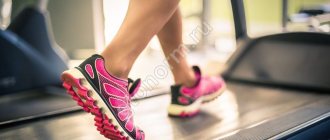Walking up stairs is practiced all over the world as an effective fat-burning and muscle-strengthening workout. Unfortunately, today more and more people lead an extremely sedentary lifestyle. They travel by car, sit in offices all day, and walk little. There is absolutely no time left for fitness or sports. As a result, heart diseases develop, muscles become flabby, excess weight and cellulite appear.
Walking stairs to lose weight or simply to maintain health is a way out for people trying to break the vicious circle. It can be practiced everywhere, for example, in the office, use the stairs instead of the elevator. At home you can also climb to your floor on foot. In shops, subways, and shopping centers, do not use escalators, but walk up and down with your feet. Thus, a person begins to lead an active lifestyle without wasting time training in the gym.
Of course, walking up the stairs will not replace a full-fledged workout in the gym. However, it will give excellent results to those who want to tighten the muscles of their legs and butts, strengthen their heart and lungs, and lose excess weight.
What muscles move when walking up stairs?
Let's find out which muscles are trained when walking up and down stairs. This will help you better understand the exercise itself, as well as why it is effective.
As you understand, descent and ascent are not the same thing. You will be surprised, but despite the fact that fewer calories are burned during the descent, the muscles work more intensely. The fact is that when a person rises, he moves his foot to a level elevation, intuitively calculating the height of the next rise. During the descent, each step is a small drop down, albeit to a certain depth. The brain and muscles work in conjunction; they constantly control the position of the body in space, experiencing a kind of stress. Thus, when going down, you strengthen and tone your muscles more, and when going up, you spend more energy, which means you lose weight.
Climbing up the stairs involves:
- Knee straighteners;
- Calf muscles;
- hamstrings;
- Gluteal muscles.
When descending, in addition to the indicated muscle groups, the quadriceps (front surface of the thigh) are included in the work.
Now you know which muscles work when walking up stairs, which means you understand why the exercise is so beneficial for the muscles of the lower body. By the way, such training involves movement, which means that many other muscle groups are involved - the back, arms, abdomen, and shoulder girdle. In addition, ligaments, joints and tendons are involved in the work.
Various training programs
You can experiment, complicate, and make your exercises on the stairs more difficult ad infinitum. The main thing is not to jump from stage to stage, so as not to get injured. To do this, it doesn’t hurt to correctly evaluate your own preparation and act accordingly.
Stair training is included in the preparatory program for tennis players. There are even special tests that evaluate their condition in this case.
For newbies
Those who have just started walking up flights of stairs should not immediately overload their body. You can take as many weights with you as possible, and it is better to make sure that they have a minimum weight (1-2 kilograms). It is also not necessary to pull dumbbells in your hands. You can simply put them in a backpack and put it on your shoulders. If you don't have dumbbells, plastic bottles filled with water or sand will help.
- For 7-14 days you need to adhere to a reduced pace of classes. The total training time should be no more than 10-20 minutes.
- Over the next two weeks, the pace can be slightly increased. For example, you can first practice running for five minutes, and then continue walking for another 10-15 minutes.
This is quite enough to get involved and get used to the new loads. After a month, you can make your training more intense to consolidate the results and improve your performance.
For athletes
After about a month of classes at the initial level, “creativity” can be included in the classes. That is, light physical exercise is added to the usual steps. Don't forget that before the first difficult lesson, a good warm-up won't hurt. Two or three flights of stairs will be a good basis for future training.
- Jumping (both up and down).
- Running up the stairs (without skipping steps).
- Lifting on tiptoes or heels.
- Long, elongated steps every 2-3 steps.
- Raises on arms and legs.
- Cross lifts.
All these exercises can be done as a complex during each workout, performing only 2-3 approaches. But it’s better to make a plan from the beginning and add them to the list. In this case, it would be best to perform cycles 3-5 times in a row, resting at the bottom to restore breathing.
For advanced
A well-developed physically person can withstand much heavier loads than a beginner or even someone who has been practicing for some time. Therefore, their level must be appropriate for the classes to produce results. First, do your usual warm-up or go up and down two or three flights.
- Run up the steps for 1-2 minutes.
- Jumping from a squat towards the top.
- Straight and reverse push-ups on steps.
- Uneven-high side squats.
Any cycle must be repeated 3-5 times to achieve the effect of the exercises. If this doesn’t seem enough to you, then you can increase the load by adding additional cycles-approaches.
Simulators that simulate walking up stairs: what to look for
Today the market offers hundreds of different exercise machines. For example, comfortable steppers can be an excellent alternative to steps. This is usually a good solution at home. It comes with instructions and makes it easy to set the load level. These are cardio machines that simulate a person climbing stairs. During exercise, the same muscles are involved, so you can pump up your buttocks, lose excess weight, make your legs and butt more beautiful and sculpted.
- There are two main classes of steppers: standard size and mini version. Everything will depend on your preferences and capabilities. The second option is much cheaper and more compact in size.
- Classic exercise machines are chosen by those who want to accurately simulate climbing stairs.
- Balance steppers are more complex, and their platform moves, forcing the athlete to maintain balance. Therefore, many more muscle groups work, for example, the back and abdominal muscles are connected.
- Rotating devices allow you to train not only your legs, hips, buttocks, but also your back muscle corset.
There are many different design differences between exercise machines. For example, there are three main types: folding, professional, autonomous. They can be electrical or mechanical, or they can be portable, that is, powered by batteries. The most popular, widespread models create loads using hydraulics or pneumatics.
Contraindications for walking on stairs
The positive aspects of training are described above, but it is also worth paying attention to the negative aspects. Not everyone is suitable for such activities, so it is recommended that you first go to your doctor, get tested, and undergo tests. Only after this can you start this sport. So what are the contraindications, what should you pay attention to first.
- Inflamed joints will become an insurmountable barrier to such training. Even if there were no problems previously, sharp pain in the joints, clicks, unpleasant sensations, some kind of squeaks, all this should force you to consult a doctor and immediately stop training.
- Thrombophlebitis, thrombosis in different stages.
- Hypertension.
- Bronchial asthma, other respiratory tract pathologies.
- Cardiovascular diseases.
- Late pregnancy.
After serious injuries or surgery, it is not advisable to begin this type of training until complete recovery. This can make the problems worse, which is completely unnecessary.
Execution technique
To get started, check out these helpful tips.
- First of all, be sure to do a warm-up - warm up the muscles of your legs and back. Perform circular rotations of the working joints, jump in place, stretch well;
- Work out in comfortable sportswear, don’t skimp on high-quality sneakers with springy soles;
- Start the lesson at a slow pace, gradually increasing it towards the middle. The last 10% of the time, slow down smoothly. Finish the workout with a small stretching routine and breathing exercises;
- While walking, breathe regularly and take moderate deep breaths. Inhale through your nose, exhale through your mouth.
- The recommended heart rate zone is 130-140 beats. /min. You can download a special fitness application to your phone or buy a fitness watch;
- For those who want to take the stairs to lose weight, for quick results, reviews recommend doing it at the fastest pace you are capable of.
- Take breaks only after going down: you go up, immediately go down - you can sit for a while.
During the movement, the leg is placed on the toe, rolling the foot onto the heel, the knee is bent to an angle of 90 degrees. The back is kept straight, the body can be slightly tilted forward while lifting. It is advisable to bend your arms at the elbows and use them to help the movement. Don't look at your feet. Put headphones in your ears – it’s more fun!
Benefits, harms and contraindications
Next, we will consider the benefits and harms of walking up the stairs, because this exercise, like any other, has its contraindications. Let's start with the pleasant things:
- Cardiologists unanimously answer the question “is it useful to walk up the stairs?” Exercise strengthens the cardiovascular system, normalizes blood pressure;
- The exercise trains the athlete’s endurance and improves breathing;
- Muscles and joints are strengthened, a beautiful relief appears, the body becomes more elastic, the skin is elastic;
- The exercise is classified as energy-intensive, so it actively promotes fat burning. Below we will tell you how to properly walk up the stairs for weight loss so that the result appears as soon as possible;
- Blood circulation is activated, especially in the pelvis, which is equally beneficial for the reproductive function of both men and women;
- Beautiful posture is formed;
- Any sports activity has a positive effect on a person’s overall emotional background - the mood rises, worries and worries fade into the background.
In what cases can walking on stairs harm an athlete?
- If you set the bar too high for yourself and start training at a very fast pace, you may experience unusual pain in your heart or joints. In this case, reduce the load and allow yourself to rest. Be sure to see a doctor;
- If you exercise in unsuitable shoes, you can injure your ankle joint. The risk of falling and twisting a leg remains for beginners who are not yet accustomed to the exercise, or who immediately practice high speed;
- If you exercise while feeling unwell, there is a risk of shortness of breath, dizziness, and weakness. Never go to training if you are sick, have a cold, have not slept well, or are very tired.
Below we list contraindications, in the presence of which walking on stairs is strictly prohibited:
- Active varicose veins;
- Conditions after a heart attack or stroke;
- Injury to the knee, ankle or hip joints. Please note that it must be diagnosed by a specialist. If your knee hurts after running, this does not mean anything and it is too early to talk about contraindications;
- Damage to the musculoskeletal system;
- Scoliosis;
- Exacerbation of chronic diseases;
- After abdominal operations;
- In inflammatory processes, including fever;
- Glaucoma;
- Severely poor vision.
Contraindications: when is it better to avoid steps?
Like any physical activity, climbing stairs has contraindications. It is recommended that you stop exercising if you have one or more of the following problems:
- advanced form of scoliosis;
- ankle, hip or knee injuries;
- pronounced varicose veins
- body mass index exceeding 33;
- serious heart disease;
- high blood pressure.
If you have venous insufficiency, you can exercise, but in a gentle manner, using compression garments or elastic bandages. In mild stages of the disease, climbing stairs has a beneficial effect on the condition of the veins, removes congestion in the legs, and tones the tissues.
Walking on stairs and pregnancy
Many expectant mothers, especially those who have recently led an active sporting life, are interested in the benefits of walking up stairs for women. And in general, is it possible to organize such training in an interesting situation?
The answer to this question will be positive, because pregnancy is not a pathological condition. On the contrary, this is a wonderful period when moderate physical activity will have a positive effect on both the woman and her baby.
- During exercise, the body absorbs more oxygen. Thus, the expectant mother, with the help of exercise, negates the risk of the baby developing hypoxia;
- Physical education strengthens muscles and ligaments, improves well-being, which means it will be easier for mom to give birth and easier to recover after childbirth;
- Of course, the load for pregnant women should be moderate. No weights, new records or tiring races. If you suddenly feel unwell, stop immediately. Exercise slowly and have fun. You will lose weight and get a bigger butt later, but now, you just need to improve your health and cheer yourself and your baby up.
- Be sure to consult your doctor before starting exercise. It is forbidden to play sports if there is a threat of miscarriage, uterine tone, bleeding, pain, or in the early stages.
- In the last trimester, we recommend wearing compression garments and a bandage.
Skyscrapers and women
Walking and running on stairs are suitable for people of all genders and ages. In Los Angeles, for example, every year there is a race to the local 77-story skyscraper. One of my friends, who regularly ran in the mountains, somehow got into this competition.
The men started there along with the women, at about a 30-second interval. After some time, she had to go around the men, who were “stormed” to the point that they did not have the strength to step aside and let other participants pass. I had to shout from afar: “Get out of the way!” And suddenly, just imagine, a lady of about 50 years old calmly and gracefully walks around her and confidently walks towards the end of the route - step by step.
By the way, the winner of the most prestigious race on the Empire State Building among women for three years in a row has been Australian Susan Walsham, who last climbed 1,500 steps to the top in just over 13 minutes. And the winner among men climbed the skyscraper only two minutes faster.
How many calories are burned?
All women who are losing weight are interested in how many calories are burned when walking up the stairs. By the way, this exercise takes much more energy than regular jogging, because during the lifting process the athlete is forced to constantly overcome the force of gravity.
- On average, a person spends 1 kcal for every 10 steps;
- Thus, at a moderate pace, he will burn 10-15 kcal per minute;
- Using simple calculations, we calculate that you can lose 600-900 kcal in an hour
Energy expenditure depends on many factors, such as the weight of the athlete. The more a person weighs, the more difficult it is for him to carry his kilograms up the stairs, and accordingly, the more calories he will spend. Also influenced by the speed of movement, the duration of the activity, and even the air temperature in the area.
As you can see, walking up the stairs is effective for losing weight - calories are burned more actively than when running (500-600 kcal per hour). By the way, when the initial load becomes familiar to you, try to speed up the pace or switch from walking up the stairs to running. Or, start using weights. This will increase the difficulty of the task, which means you will burn many more calories. If you are trying to lose weight, remember to eat healthy, get enough sleep and rest.
Cardio workout: how many calories does it burn?
How many calories are burned when squatting?
You should know how many calories a cardio workout burns with a weight of 60 kg in 30 minutes:
- step aerobics - 295 kcal;
- exercise bike - 208 kcal;
- swimming - 247 kcal;
- walking 6 km per hour - 152 kcal;
- running 10 km per hour - 249 kcal.
Swimming underwater
Sample lesson program
If you have just started training, do not take weights. Exercise 2-3 times a week for 15-30 minutes at a slow pace. After a couple of weeks, you can increase your walking speed.
For athletes with normal physical shape, we recommend adding light exercise elements to walking up stairs:
- Jumping up – 20-30 times;
- Tiptoe lifts 40-70 times;
- Swing your legs forward, backward and to the sides 30 times;
- Next, walk up the stairs for 10-15 minutes at a moderate pace;
- 5-10 minutes brisk walking (almost running);
- 10 minutes gradually reduce walking speed.
- Several stretching exercises.
For experienced athletes, we recommend making the task more difficult for themselves, for example, hanging a backpack with weights on their backs, or picking up dumbbells. Try interval running at alternating speeds.
We studied reviews and results about walking on stairs for weight loss, and concluded that the exercise is very effective. Women who purposefully go to stadiums to run up and down the stairs say they were able to lose 5 to 10 kg in a month. At the same time, of course, they followed a proper diet, drank a lot of water and combined walking up the stairs with other exercises.
As they say, the one who walks can master the road, which means the main thing is to start training. Try it today, away with the elevator, walk up home!
How to walk up stairs correctly for weight loss
Basic principles of losing weight by walking up stairs:
- To burn fat, you need to eat no later than 1 hour before training. Otherwise, energy will be taken from the last meal rather than from fat reserves.
- The workout should last at least 30, but no more than 60 minutes. First, glucose stored in the blood after eating, as well as glycogen stored in muscle tissue, are used to release energy. The transition to fat burning occurs 20 minutes from the start of the workout. If you walk for more than 1 hour, your muscles begin to break down. This cannot be allowed.
- You need to do at least 3 workouts per week. With good physical fitness and quick recovery, you can walk up the stairs every day.
- While walking up the stairs, you need to maintain an optimal heart rate (heart rate, or heart rate) for fat burning. To calculate it, subtract your age in years from 220. First multiply the result by 0.6 and then by 0.7. You will get a heart rate range at which active breakdown of adipose tissue occurs.
An example of calculating the optimal heart rate range for a person aged 30:
- Subtract age from 220. 220-30=190. This will be your maximum heart rate. It cannot be exceeded, it is dangerous for the heart.
- Multiply 190 by 0.6. 190*0.6=114. This is the minimum heart rate that supports the fat burning process while walking up the stairs.
- Multiply 190 by 0.7. 190*0.7=133. This is the upper limit of the heart rate. If it is exceeded, muscle tissue will be destroyed, not fat tissue.
During training, you should try to keep your heart rate in the range that was obtained in the calculations. But it doesn't have to be done with high precision. So, the calculations above can be rounded. Then the range expands: from 110 to 135 beats per minute.
Be sure to read: What should fitness be like for weight loss, as well as other tips
Advice! Adjust your heart rate by decreasing or increasing your speed on stairs. With each new workout, your heart will become stronger.
Therefore, over time, you will be able to run up the stairs, and your heart rate will not exceed the optimal range for fat burning.
Walking on stairs for untrained people
Half-hour workouts are difficult for people with poor physical fitness. Therefore, you need to increase the load gradually. Approximate load increase scheme:
- On the first day, walk up the stairs very slowly for 10 minutes. You can go up and down only 2-3 times. But for the first time this will be enough.
- On the second day, do 1 more up-and-down cycle, and on the third, 1 more, etc., until the workout time is 30 minutes.
- Next, continue to increase your training time to 60 minutes, and also increase the speed of climbing stairs.
- Monitor your pulse. If it's too slow, speed up; if it's too fast, slow down.
After training, do not stop abruptly. Continue moving until your heart rate returns to normal and your breathing is restored.
To do this, take a leisurely walk down the street, taking deep breaths through your nose and slowly exhaling through your mouth.











